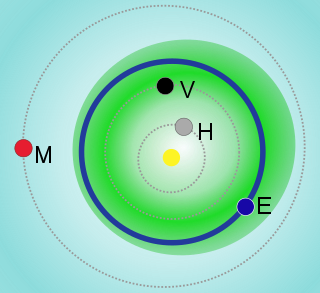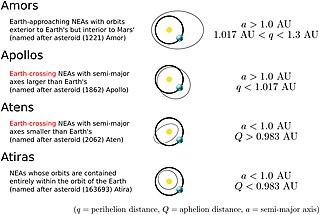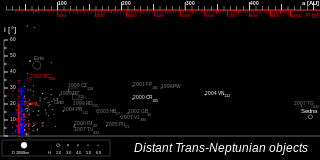In astronomy, the plutinos are a dynamical group of trans-Neptunian objects that orbit in 2:3 mean-motion resonance with Neptune. This means that for every two orbits a plutino makes, Neptune orbits three times. The dwarf planet Pluto is the largest member as well as the namesake of this group. The next largest members are Orcus, (208996) 2003 AZ84, and Ixion. Plutinos are named after mythological creatures associated with the underworld.

The Apollo asteroids are a group of near-Earth asteroids named after 1862 Apollo, discovered by German astronomer Karl Reinmuth in the 1930s. They are Earth-crossing asteroids that have an orbital semi-major axis greater than that of the Earth but perihelion distances less than the Earth's aphelion distance.

An apsis is the farthest or nearest point in the orbit of a planetary body about its primary body. The line of apsides is the line connecting the two extreme values.

The Hilda asteroids are a dynamical group of more than 5,000 asteroids located beyond the asteroid belt but within Jupiter's orbit, in a 3:2 orbital resonance with Jupiter. The namesake is the asteroid 153 Hilda.

The Aten asteroids are a dynamical group of asteroids whose orbits bring them into proximity with Earth. By definition, Atens are Earth-crossing asteroids (a < 1.0 AU and Q > 0.983 AU). The group is named after 2062 Aten, the first of its kind, discovered on 7 January 1976 by American astronomer Eleanor Helin at Palomar Observatory. As of November 2023, 2,646 Atens have been discovered, of which 256 are numbered, 14 are named, and 102 are classified as potentially hazardous asteroids.

The Amor asteroids are a group of near-Earth asteroids named after the archetype object 1221 Amor. The orbital perihelion of these objects is close to, but greater than, the orbital aphelion of Earth, with most Amors crossing the orbit of Mars. The Amor asteroid 433 Eros was the first asteroid to be orbited and landed upon by a robotic space probe.

(612911) 2004 XR190, nicknamed Buffy, is a trans-Neptunian object, classified as both a scattered disc object and a detached object, located in the outermost region of the Solar System. It was first observed on 11 December 2004, by astronomers with the Canada–France Ecliptic Plane Survey at the Mauna Kea Observatories, Hawaii, United States. It is the largest known highly inclined (> 45°) object. With a perihelion of 51 AU, it belongs to a small and poorly understood group of very distant objects with moderate eccentricities.

The proper orbital elements or proper elements of an orbit are constants of motion of an object in space that remain practically unchanged over an astronomically long timescale. The term is usually used to describe the three quantities:

Detached objects are a dynamical class of minor planets in the outer reaches of the Solar System and belong to the broader family of trans-Neptunian objects (TNOs). These objects have orbits whose points of closest approach to the Sun (perihelion) are sufficiently distant from the gravitational influence of Neptune that they are only moderately affected by Neptune and the other known planets: This makes them appear to be "detached" from the rest of the Solar System, except for their attraction to the Sun.

2012 DR30 is a trans-Neptunian object and centaur from the scattered disk and/or inner Oort cloud, located in the outermost region of the Solar System. The object with a highly eccentric orbit of 0.99 was first observed by astronomers with the Spacewatch program at Steward Observatory on 31 March 2009. It measures approximately 188 kilometers (120 miles) in diameter.

2013 BL76 is a trans-Neptunian object and centaur from the scattered disk and Inner Oort cloud approximately 30 kilometers in diameter.

2005 HC4 is the asteroid with the smallest known perihelion of any known object orbiting the Sun (except sungrazing comets). Its extreme orbital eccentricity brings it to within 0.071 AU of the Sun (23% of Mercury's perihelion) and takes it as far as 3.562 AU from the Sun (well beyond the orbit of Mars). Due to its very small perihelion and comparably large aphelion, 2005 HC4 achieves the fastest speed of any known asteroid bound to the Solar System with a velocity of 157 km/s (565,000 km/h; 351,000 mi/h) at perihelion (there are comets, however, which obtain much higher speeds).
2005 VX3 is trans-Neptunian object and retrograde damocloid on a highly eccentric, cometary-like orbit. It was first observed on 1 November 2005, by astronomers with the Mount Lemmon Survey at the Mount Lemmon Observatory in Arizona, United States. The unusual object measures approximately 7 kilometers (4 miles) in diameter. It has the 3rd largest known heliocentric semi-major axis and aphelion. Additionally its perihelion lies within the orbit of Jupiter, which means it also has the largest orbital eccentricity of any known minor planet.
2002 RN109 is a trans-Neptunian astronomical object and damocloid on a highly eccentric, cometary-like orbit. It was first observed on 6 September 2002, by astronomers of the Lincoln Near-Earth Asteroid Research project at its ETS near Socorro, New Mexico, United States. The unusual object is approximately 4 kilometers (2 miles) in diameter. It has the second-highest orbital eccentricity of any known minor planet, after 2005 VX3.
2017 MB7 is a trans-Neptunian object and damocloid on a cometary-like orbit from the outer Solar System, approximately 6 kilometers (4 miles) in diameter. It was first observed on 22 June 2017 by the Pan-STARRS survey at Haleakala Observatory in Hawaii, United States. This unusual object has the largest heliocentric aphelion, semi-major axis, orbital eccentricity and orbital period of any known periodic minor planet, even larger than that of 2014 FE72; it is calculated to reach several thousand AU (Earth-Sun) distances at the farthest extent of its orbit.

2019 AQ3 is an inclined near-Earth object of the small Atira group from the innermost region of the Solar System, estimated to measure 1.4 kilometers (0.9 miles) in diameter. Among the hundreds of thousands known asteroids, 2019 AQ3's orbit was thought to have likely the smallest semi-major axis (0.589 AU) and aphelion (0.77 AU), that is, the orbit's average distance and farthest point from the Sun, respectively. The object was first observed on 4 January 2019, by astronomers at Palomar's Zwicky Transient Facility in California, with recovered images dating back to 2015.

594913 ꞌAylóꞌchaxnim (provisional designation 2020 AV2) is a large near-Earth asteroid discovered by the Zwicky Transient Facility on 4 January 2020. It is the first asteroid discovered to have an orbit completely within Venus's orbit, and is thus the first and only known member of the eponymous ꞌAylóꞌchaxnim (informally named Vatira before its discovery) population of Atira-class asteroids. ꞌAylóꞌchaxnim has the smallest known aphelion and third-smallest known semi-major axis among all asteroids. With an absolute magnitude approximately 16.2, the asteroid is expected to be larger than 1 km in diameter.
2014 ST373 (prov. designation:2014 ST373) is a trans-Neptunian object and a detached object from the outermost region of the Solar System. With a perihelion of 50.2 AU, it belongs to the top 10 minor planets with the highest known perihelia of the Solar System. and is neither a scattered disc nor an extreme trans-Neptunian object. It measures approximately 370 kilometers (230 miles) in diameter and was first observed on 25 September 2014, by astronomers using the Dark Energy Camera (DECam) at Cerro Tololo Inter-American Observatory in Chile.